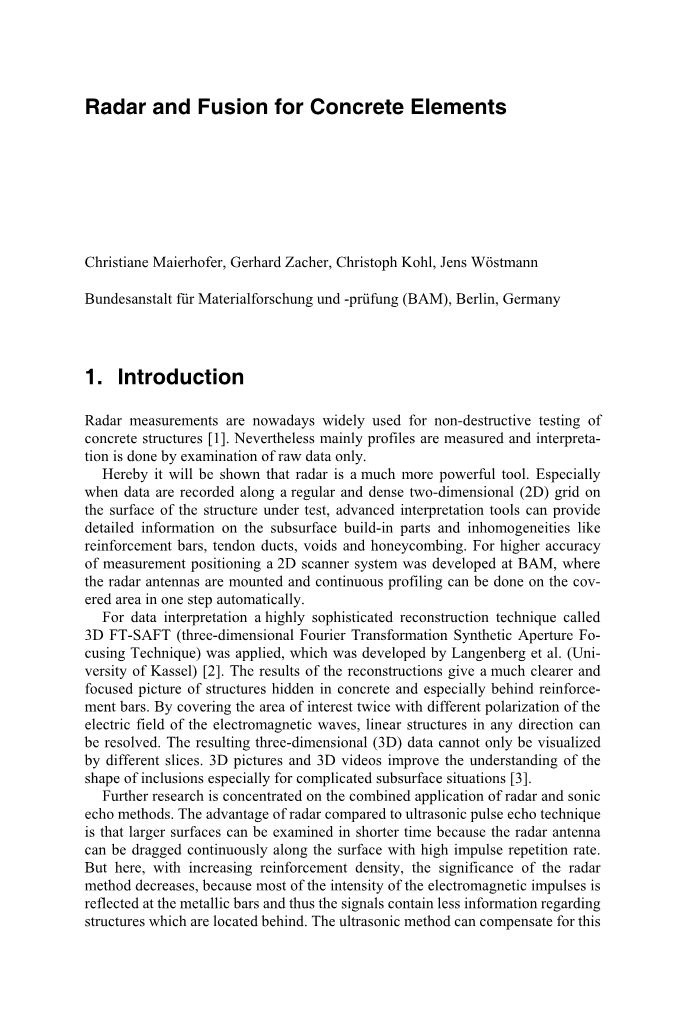

英语原文共 8 页,剩余内容已隐藏,支付完成后下载完整资料
Radar and Fusion for Concrete Elements
混凝土构件的雷达与融合
Christiane Maierhofer, Gerhard Zacher, Christoph Kohl, Jens Wouml;stmann
Bundesanstalt fuuml;r Materialforschung und -pruuml;fung (BAM), Berlin, Germany
1. Introduction
1. 介绍
Radar measurements are nowadays widely used for non-destructive testing of concrete structures [1]. Nevertheless mainly profiles are measured and interpreta-tion is done by examination of raw data only.
雷达测量在混凝土结构无损检测中得到了广泛的应用。然而,主要的剖面是通过测量的,解释仅仅是通过对原始数据的检验来完成的。
Hereby it will be shown that radar is a much more powerful tool. Especially when data are recorded along a regular and dense two-dimensional (2D) grid on the surface of the structure under test, advanced interpretation tools can provide detailed information on the subsurface build-in parts and inhomogeneities like reinforcement bars, tendon ducts, voids and honeycombing. For higher accuracy of measurement positioning a 2D scanner system was developed at BAM, where the radar antennas are mounted and continuous profiling can be done on the cov-ered area in one step automatically.
在此,我们将看到雷达是一个更强大的工具。特别是当数据被记录在一个规则且密集的二维(2D)网格上被测试的结构表面时,进一步的解释工具可以提供关于地下构件的详细信息,如钢筋、筋管、空洞和蜂窝状结构等。为了更高的准确度,在BAM平台上开发了一个二维扫描系统,实现了雷达天线的安装和连续剖面的自动测量。
For data interpretation a highly sophisticated reconstruction technique called 3D FT -SAFT (three-dimensional Fourier Transformation Synthetic Aperture Fo-cusing Technique) was applied, which was developed by Langenberg et al. (Uni-versity of Kassel) [2]. The results of the reconstructions give a much clearer and focused picture of structures hidden in concrete and especially behind reinforce-ment bars. By covering the area of interest twice with different polarization of the electric field of the electromagnetic waves, linear structures in any direction can be resolved. The resulting three -dimensional (3D) data cannot only be visualized by different slices. 3D pictures and 3D videos improve the understanding of the shape of inclusions especially for complicated subsurface situations [3].
在数据解释方面,应用了一种由兰根伯格等人(卡塞尔市大学)开发的非常复杂的重建技术,即三维傅里叶变换合成孔径聚焦技术。重建的结果使人们对混凝土结构特别是加固后的结构有了更清晰、更集中的了解。通过两次覆盖感兴趣区域,不同极化的电磁波,可以求解任意方向的线性结构。最后得到的3维图像数据不能只通过不同的切片来可视化。三维图像和三维视频提高了对包裹体形状的理解,特别是在复杂的地下环境中。
Further research is concentrated on the combined application of radar and sonic echo methods. The advantage of radar compared to ultrasonic pulse echo technique is that larger surfaces can be examined in shorter time because the radar antenna can be dragged continuously along the surface with high impulse repetition rate. But here, with increasing reinforcement density, the significance of the radar method decreases, because most of the intensity of the electromagnetic impulses is reflected at the metallic bars and thus the signals contain less information regarding structures which are located behind.
进一步的研究集中在雷达和声波回波方法的结合应用上。与超声波脉冲回波技术相比,雷达的优点是在较短的时间内可以检测更大的表面。由于雷达天线可以连续地沿地面拖动,具有较高的脉冲重复频率。但是,随着钢筋密度的增加,雷达方法的重要性降低,因为大部分电磁脉冲的强度都反映在金属条上,因此信号包含的关于位于后面的结构的信息较少。
632 Christiane Maierhofer et al.
The ultrasonic method can compensate for this deficit, since the ultrasonic waves can penetrate through metal. On the other hand ultrasonic waves are totally reflected at air gaps, whereas for the radar method air layers are transparent and only little intensity is reflected, so that both methods complement each other very effectively [4].
超声波可以补偿这个缺陷,因为超声波能穿透金属。另一方面,超声波完全反射在空气间隙,而对于雷达方法的空气层是透明的,反射强度很小,因此这两种方法都是非常有效的互补。
With data fusion the different information can be combined to obtain a complete picture of subsurface structures independent of polarization direction or frequency. This method can be applied for data recorded with the same method but different sensor configurations (e. g. polarisation, frequency), and/or for com-plementary data sets as ultrasonic echo and radar to improve the information con-tent of structures in the specific volume and to enlarge the overall depth range [5].
通过数据融合,可以将不同的信息组合在一起,得到与极化方向或频率无关的地下结构的完整图像。该方法可用于数据处理。用相同的方法记录,但传感器配置不同(如极化、频率)或用于诸如超声回波和雷达等基本数据集,以提高信息含量和扩大整体深度范围。
All described results were achieved in the framework of the German research group FOR 384, whereas Prof. H. W. Reinhardt is the speaker.
In the following some results obtained during the six years work are presented concerning the work packages C Radar, D3 Combined Methods, Data Fusion, E Performance Demonstration and the application of the methods on site.
所有上述结果都是在德国384研究小组的框架内取得的,而H.W.Reinhardt教授则是演讲者。
在接下来的六年工作中,我们介绍了C雷达、D3组合方法、数据融合、E性能演示和应用等方面的一些成果和该方法在现场的应用。
- Radar applications at reinforced concrete structures
雷达在钢筋混凝土结构中的应用
Radar is a non-destructive testing (NDT) technique based on the propagation of electromagnetic waves of high frequency: typically between 200 MHz and 2.5 GHz for civil engineering applications. The waves are emitted by an antenna (transmitter), which is in most cases in direct contact (not necessarily needed) with the structure under investigation and moves along the surface. The waves travel through the medium and are reflected at interfaces of materials with different dielectric properties, such as at interfaces of concrete or plaster to other layers of concrete, to voids, to metal and to other inhomogeneities. The permittivity and the conductivity of materials strongly affect the propagation of electromagnetic waves. For example radar investigation is almost impossible in fresh concrete due to the high moisture content. Furthermore electromagnetic waves cannot penetrate through metal. Therefore radar cannot be used to investigate the grouting condi-tion inside metal ducts. However, it can be applied very effectively to locate metal reinforcement.
雷达是一种基于高频电磁波传播的无损检测(NDT)技术,其频率一般在200 MHz~2.5GHz之间,适用于土
全文共26141字,剩余内容已隐藏,支付完成后下载完整资料
资料编号:[17032],资料为PDF文档或Word文档,PDF文档可免费转换为Word
以上是毕业论文外文翻译,课题毕业论文、任务书、文献综述、开题报告、程序设计、图纸设计等资料可联系客服协助查找。


